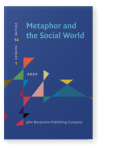Vol. 12:1 (2022) ► pp.115–137
The affect bias in the metaphorical representation of anticipated events
The case of approach
When talking about anticipated events, speakers can conceptualize them either as destinations towards which they are moving or as entities moving towards them, which correspond to the Ego- and the Time-moving metaphors, respectively (cf. ‘We are approaching Christmas’ and ‘Christmas is approaching’). Research in psycholinguistics has shown affective valence, i.e. whether the conceptualized event is perceived as positive or negative, to be one of the factors that modulate metaphor choice; positive anticipation is preferentially associated with Ego-moving expressions, whereas negative anticipation is predominantly associated with Time-moving metaphors. This paper sets out to test if the time-affect association surfaces in naturally-occurring language use when both metaphorical patterns are available. By focusing on the temporal usage of the verb approach, we provide linguistic evidence in favor of such an affective bias in time representations. In addition, the language data point to a semantic preference for a particular type of event (i.e., personal vs social) under each metaphorical pattern. We interpret this finding as preliminary evidence for a possible semantic bias in time representations to be further investigated.
Article outline
- 1.Introduction
- 2.The affective bias in time representations
- 3.The semantics of approach: A frame-semantic account
- 4.Data collection and methods: The event collocates of approach
- 5.Data annotation and results: The affective valence of approaching events
- 6.Discussion
- 7.Conclusions
- Notes
-
References -
Electronic resources accessed online
